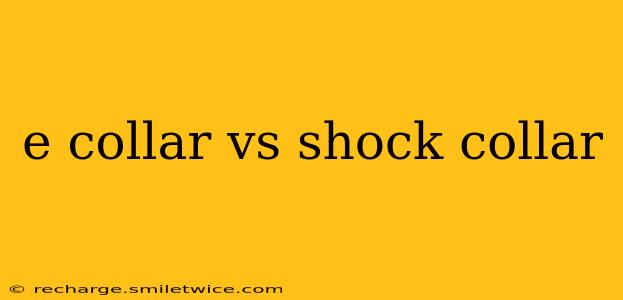The terms "e-collar" and "shock collar" are often used interchangeably, leading to confusion among pet owners. While they share some similarities, there are crucial differences that impact their effectiveness and ethical implications. This article clarifies the distinctions between e-collars and shock collars, helping you make an informed decision about the best training tool for your dog.
What is an E-Collar?
An e-collar, short for electronic collar, is a broad term encompassing various devices used for dog training. These collars utilize different stimulation methods, including:
- Vibration: A gentle vibration alerts the dog to unwanted behavior.
- Tone: An audible signal acts as a warning or cue.
- Static Stimulation (often incorrectly called a "shock"): A brief, low-level electrical pulse. The intensity is adjustable, and the goal isn't to inflict pain, but to create a deterrent. Many modern e-collars offer multiple levels of intensity.
It's important to note that not all e-collars deliver a shock. Many solely rely on vibration and tone, making them suitable for sensitive dogs or those with certain health conditions.
What is a Shock Collar?
A shock collar, often considered a subset of e-collars, specifically refers to devices that deliver static stimulation as their primary training method. The term often carries negative connotations because of the potential for misuse and the association with harsh training methods. While some users advocate for their effectiveness, there are significant ethical concerns surrounding their use.
What are the Differences Between E-Collars and Shock Collars?
The key difference lies in the emphasis of the training method. E-collars encompass a wider range of stimulation types, with static stimulation being only one option. Shock collars, on the other hand, primarily (and often solely) rely on static stimulation, which can be painful if misused. The responsible and ethical use of any training tool, including e-collars, requires careful consideration of the dog's temperament, training methods, and the expertise of the handler.
Are E-Collars Cruel?
Whether or not an e-collar is cruel depends entirely on its use. In the hands of a responsible and knowledgeable trainer, an e-collar can be a valuable tool for teaching dogs commands and managing behavioral issues, particularly in situations where other methods have proven ineffective. However, misuse can certainly lead to cruelty and cause significant harm to the dog. The key is proper training and understanding of the tool, which often necessitates professional guidance.
Are Shock Collars Safe?
The safety of shock collars is debatable. While properly used, with appropriate intensity levels and by a trained handler, injuries are rare. However, the risk of burns, skin irritation, and psychological trauma is present. Furthermore, the potential for misuse is high, and many dogs experience significant fear and anxiety due to improper or excessive use of these collars.
How to Choose the Right Training Tool:
The choice between an e-collar (with or without static stimulation) and other training methods hinges on several factors:
- Your dog's temperament and breed: Some dogs respond better to gentler methods than others.
- Your training experience and knowledge: Improper use can be detrimental. Professional guidance is strongly recommended.
- The severity of the behavioral issue: Some issues may require more intensive methods than others.
- Ethical considerations: Prioritize methods that prioritize positive reinforcement and avoid causing unnecessary pain or distress.
Always consult a certified professional dog trainer before using any e-collar or shock collar. They can assess your dog's needs and help you determine the most appropriate and humane training method.
What are the Alternatives to E-Collars and Shock Collars?
Numerous humane and effective training methods exist, including:
- Positive reinforcement: Rewarding desired behaviors with treats, praise, or toys.
- Clicker training: Using a clicker to mark desired behaviors, followed by reinforcement.
- Basic obedience training: Teaching commands such as sit, stay, and come.
- Socialization: Properly socializing your dog can prevent many behavior problems.
Ultimately, the decision of whether or not to use an e-collar or shock collar is a personal one. However, it's crucial to approach the decision with careful consideration, thorough research, and professional guidance to ensure the safety and well-being of your canine companion. The focus should always be on humane and effective training methods that build a positive relationship between you and your dog.
